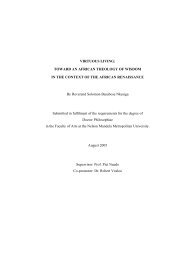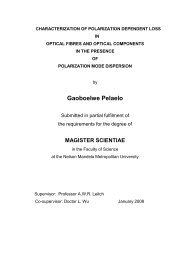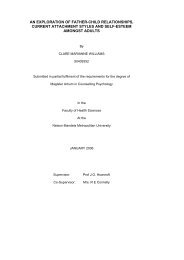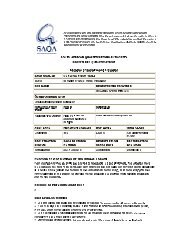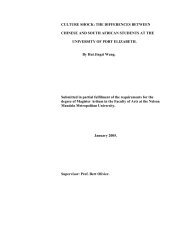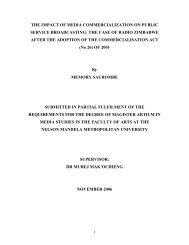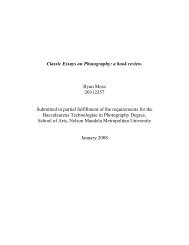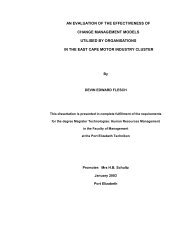an investigation into the antibacterial activities of medicinal plants ...
an investigation into the antibacterial activities of medicinal plants ...
an investigation into the antibacterial activities of medicinal plants ...
Create successful ePaper yourself
Turn your PDF publications into a flip-book with our unique Google optimized e-Paper software.
skin conditions <strong>an</strong>d internally for coughs, colds, influenza, bronchitis, high blood<br />
pressure <strong>an</strong>d headaches (Table 1) (V<strong>an</strong> Wyk et al., 1997; Hutchings, 1996).<br />
Leonotis leonurus contains a volatile oil <strong>an</strong>d <strong>an</strong> unusual diterpenoid namely marubiin.<br />
The actual pharmacological effect <strong>of</strong> marubiin in Leonotis species is not known (V<strong>an</strong><br />
Wyk et al., 1997).<br />
2.2.3.3 Meli<strong>an</strong>thus major<br />
The genus Meli<strong>an</strong>thus is restricted to Sou<strong>the</strong>rn Africa with Meli<strong>an</strong>thus major <strong>an</strong>d<br />
Meli<strong>an</strong>thus comosus mainly used in a similar m<strong>an</strong>ner for <strong>medicinal</strong> purposes.<br />
Meli<strong>an</strong>thus major belongs to <strong>the</strong> family Meli<strong>an</strong>thaceae with a wide distribution in<br />
South Africa, mainly in <strong>the</strong> dry interior. The multi-br<strong>an</strong>ched M. major has greyishgreen<br />
leaves with ruffled edges <strong>an</strong>d characteristic large clusters <strong>of</strong> dark purplish-red<br />
flowers at <strong>the</strong> br<strong>an</strong>ch end (Figure 1).<br />
Decoctions <strong>an</strong>d poultices <strong>of</strong> M. major leaves are widely used in <strong>the</strong> treatment <strong>of</strong> skin<br />
conditions (Table 1) <strong>an</strong>d o<strong>the</strong>r ailments. The Afrika<strong>an</strong>s <strong>an</strong>d English common names<br />
<strong>of</strong> M. major are ‘kruidjie-roer-my-nie’ <strong>an</strong>d ‘gi<strong>an</strong>t honey flower’, respectively.<br />
Traditionally fresh leave <strong>an</strong>d root preparations are mainly used externally for<br />
<strong>medicinal</strong> purposes due to its toxicity for internal consumption (V<strong>an</strong> Wyk et al., 1997;<br />
http://www.pl<strong>an</strong>tzafrica.com/pl<strong>an</strong>tklm/meli<strong>an</strong>thusmajor.htm).<br />
Leaf poultices <strong>an</strong>d decoctions <strong>of</strong> M. major are directly applied to impetigo, septic<br />
wounds, sores, ringworm, bruises, backache <strong>an</strong>d rheumatic joints. Traditionally dried<br />
<strong>an</strong>d powdered leaves are applied directly to sores <strong>an</strong>d open burn wounds. The<br />
powdered, dried leaves are reported to relieve pain, retract <strong>the</strong> wound <strong>an</strong>d facilitate<br />
healing (V<strong>an</strong> Wyk & Gericke, 2000).<br />
The toxicity <strong>of</strong> Meli<strong>an</strong>thus species for internal consumption is due to <strong>the</strong> presence <strong>of</strong><br />
heart glycosides, such as meli<strong>an</strong>thusigenin in Meli<strong>an</strong>thus species. Although nothing<br />
appears to be known about <strong>the</strong> wound healing properties, <strong>the</strong> <strong>medicinal</strong> value <strong>of</strong><br />
Meli<strong>an</strong>thus may be due to triterpenoids in <strong>the</strong> leaves <strong>an</strong>d roots (V<strong>an</strong> Wyk et al.,<br />
1997).<br />
22



